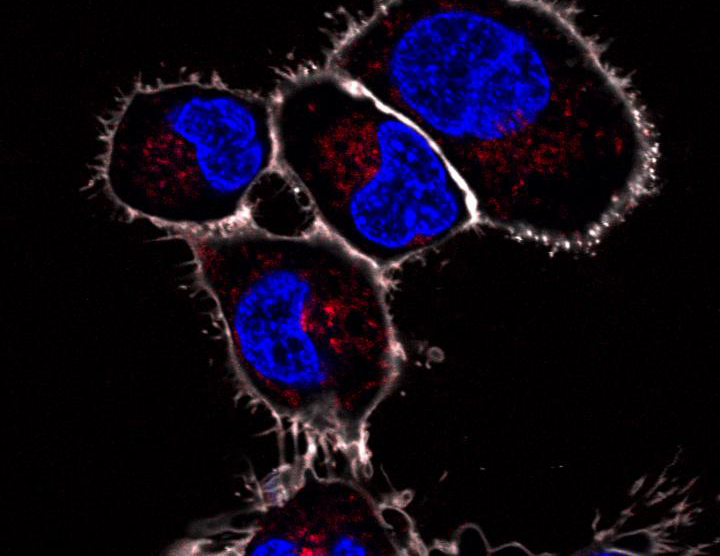Scientists at the University of Basel in Switzerland have created artificial organelles (AOs) that can function as tiny intracellular implants in living organisms. When tested in zebrafish embryos, membrane-bound, horseradish peroxidase-carrying AOs were taken up readily by cells in the embryos, where the encapsulated enzymes were activated in response to intracellular redox changes. The interdisciplinary research team, headed by Cornelia Pavilan, Ph.D., at the University’s department of chemistry, claim their achievement could pave the way to the development of new forms of personalized therapy.
“We've now been able to integrate these controllable artificial organelles into the cells of a living organism for the first time,” says Dr. Palivan. The team reports on development of their AOs in Nature Communications, in a paper entitled “Biomimetic Artificial Organelles with In Vitro and In Vivo Activity Triggered by Reduction in Microenvironment.”
AOs are composed of artificial nanospheres that compartmentalize active compounds, such as enzymes, proteins, or catalysts, and which can function in the intracellular environment. Their basic concept is “particularly attractive” as a foundation for developing biomimetic nanostructures, because they could feasibly be used to change cellular conditions and reactions, detoxify harmful compounds, or provide signals for other cellular functions, the authors expalin. While various prototype AO systems have been developed based on liposomes, porous silica nanoparticles, or polymer compartments known as polymersomes, “to the best of our knowledge, none has been assessed in vivo,” the team states. “In vivo functionality of such AOs is a crucial factor that is necessary to demonstrate that the concept of AOs is feasible in living organisms, and thus AOs can act as cellular implants.”
Natural organelles have membranes to retain compartmentalization and confine reaction spaces. This compartmentalization should be a key feature of AOs, the authors point out. Another essential factor for fine-tuning AO functionality is the triggered response to environmental cues, such as redox state. Polymersomes represent ideal candidates for creating AOs, the team suggests. These self-organizing hollow spheres have a membrane that acts as a boundary for an inner cavity, and also give the spheres greater mechanical stability than is exhibited by AOs based on liposomes.
To generate prototype controllable AOs, the team constructed polymersomes encapsulating a horseradish peroxidase enzyme that is only activated when specific molecules penetrate through the outer membrane. Horseradish peroxidase was chosen as a model enzyme because peroxidases play a significant role in redox homeostasis of cells. Control of enzyme activity was achieved by incorporating into the polymersome membrane genetically modified porin channels that act as redox-responsive gates. In low-glutathione environments, the membrane proteins are closed, so no molecules can penetrate the AO, but the gates are triggered to open and let in small-molecular-weight molecules when concentration of the reducing agent glutathione rises above a specific threshold. “This approach mimics pathways of metabolism regulation, where proteins within the membranes of natural cell organelles are irreversibly activated or deactivated on demand,” the team writes.
The team’s polymersome AOs were first evaluated in vitro and then tested in a zebrafish embryos. The zebrafish embryo model is ideal because the embryos are transparent, which allowed the researchers to visualize their fluorescent dye–tagged intracellular implants under a microscope. The studies demonstrated that when AOs containing horseradish peroxidase were injected into the zebrafish embryos, they were taken up by the cell’s macrophages. Peroxidase enzyme activation was then triggered by the hydrogen peroxide produced by macrophages entering the AO cavity through the opened protein gates.
“Our AOs preserved their architecture and were activated after reaching the cellular microenvironment,” the team writes. “More exciting, they are functional in a vertebrate ZFE [zebrafish embryo] model, which proves that the concept of AOs as cellular implants is feasible in vivo.” The authors suggest that by changing the encapsulated enzymes and/or of the stimuli-responsive property of the protein gates their basic AO strategy could be adapted for the development of a wide variety of AOs for different clinical applications.
“This example of AOs activated by changes in cellular microenvironment and that remains functional in vivo, opens the perspective of complex in situ reactions inside AOs, and represents an important advance towards the generation of multifunctional systems that will support the development of personalised medicine,” they conclude. “We believe that in the future, the high versatility of our strategy will allow straightforward development of a large variety of AOs for specific medical applications by changing the encapsulated enzymes and/or of the stimuli-responsive property of the protein gates.”


